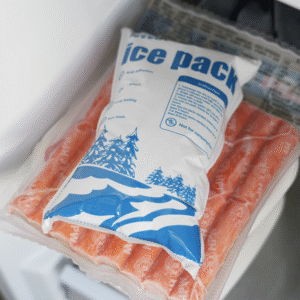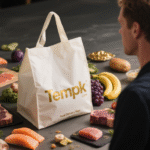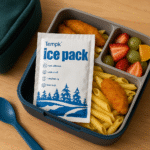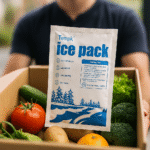Updated: August 18, 2025
You’re searching for dry ice packs Woolworths and need a straight, up‑to‑date answer. As of August 18, 2025, Woolworths sells gel ice packs and freezer bricks, not CO₂ dry ice. This guide shows you exactly what to buy for chilled or frozen food, how to pack and label boxes, and a simple rule to size dry ice (5–10 lb per day). Insights reflect current AU/NZ retail listings and carrier rules .
-
dry ice packs Woolworths availability and what you actually get in store.
-
How to choose between gel, PCM, and CO₂ dry ice for your route.
-
Exactly how to pack, label, and vent a frozen box for air or road.
-
How much dry ice to buy and when PCM beats dry ice for simplicity.
-
2025 updates on carrier acceptance, safety, and sustainable insulation.
Do dry ice packs Woolworths actually keep food frozen long enough?
If you arrived here after searching dry ice packs Woolworths, this section gives you the quick, practical answer you need.
Short answer: use gel bricks from Woolworths for chilled windows and real dry ice for multi‑day frozen holds. In stores, “dry ice packs” means reusable gel bricks, which hold about 0–5 °C for hours. To keep ice cream or meat frozen for 24–72 hours, you’ll need CO₂ dry ice in a vented shipper with UN1845 labels. Plan roughly 2.3–4.5 kg per 24 hours per small cooler. That’s the practical line between gel convenience at Woolworths and true frozen control with dry ice.
Think about your lane first: distance, outside temperature, and target range. For chilled groceries or last‑mile meal kits, dry ice packs Woolworths (gel bricks) are perfect—fast, safe, no hazmat steps. For frozen shipments over 12–36 hours, switch to phase‑change material (PCM −20 °C) or true dry ice. Dry ice sits at about −78.5 °C and must be packed in ventilated boxes; never airtight. Air services and some couriers have clear rules, and business accounts may use dry ice on specific networks with correct markings. Pre‑freeze the payload to ≤ −18 °C, fill voids, and keep coolant on top and bottom for even headspace cooling. Following these basics prevents “half‑thawed on arrival” surprises.
How much dry ice do you really need for 24–72 hours?
Many readers type dry ice packs Woolworths when they really need guidance on gel vs dry ice—here’s how to decide fast.
For planners searching dry ice packs Woolworths and then buying real dry ice elsewhere, use this simple estimator. Start at 2.3–4.5 kg per 24 h for an 8–15 L insulated shipper. Multiply by transit days, then adjust for insulation quality and heat. Example: a 36‑hour interstate lane in summer with a 12 L box needs about 7–9 kg total. Always pre‑chill the shipper, hard‑freeze the product, and place dry ice above and below the payload. Validate on your route once, then fine‑tune ±10–20% by season.
| Refrigerant choice | Temp range | Typical hold | What it means for you |
|---|---|---|---|
| Gel ice packs (dry ice packs Woolworths) | ~0–5 °C | Hours to ~1 day | Easy chilled control for groceries and short hops; no hazmat. |
| PCM sub‑zero bricks | −5 °C to −25 °C | 1–2 days+ | Strong frozen support without UN1845 paperwork; pack tightly. |
| Dry ice (CO₂, UN1845) | ≈ −78.5 °C | 1–3 days+ | Best for deep‑frozen shipments; vented shipper and labels required. |
Practical tips you can use today
Bookmark this if dry ice packs Woolworths is a frequent query from your team or customers.
-
Metro grocery run: Freeze two gel bricks overnight, place one on top inside an insulated bag, and keep openings minimal.
-
Same‑day ecommerce: Combine gel bricks with a dense liner; stage orders in a pre‑chilled tote before courier pickup.
-
48–72 h frozen: Book dry ice, use a validated EPS/EPP shipper, label UN1845 with net kg, and leave a vent path.
Real‑world case: A Sydney meal‑prep brand moved from gel bricks to dry ice for a 36‑hour interstate run. Ice‑crystal retention in ice cream improved, temperatures stayed below −18 °C, and customer complaints dropped. They kept gel for local drops and reserved dry ice for linehaul, reducing spoilage and chargebacks without increasing packing time.
Where can you buy real dry ice if “dry ice packs Woolworths” isn’t true dry ice?
For teams that ask about dry ice packs Woolworths, the labeling checklist below prevents avoidable delays.
Get gel bricks at Woolworths; get CO₂ dry ice from specialty suppliers. Supermarkets stock reusable gel packs and freezer bricks. For pellets or slabs of dry ice, use gas suppliers with local depots and delivery options. Plan pickup windows, minimum order sizes, and holiday hours. Carry insulated gloves and a vented cooler; transport in a well‑ventilated vehicle. Order one day ahead to avoid stockouts during heatwaves.
When your route demands frozen‑solid control, bypass retail and buy dry ice from a gas or industrial supplier. They offer different formats—pellets for surface coverage and slabs for longer hold time. Ask about pellet size (e.g., 3 mm vs 10 mm) and packaging (poly bags vs waxed boxes), because sublimation rates vary. Confirm weekend hours and whether they can split orders for multiple pickups. Some couriers accept UN1845 with proper markings on specific services, while others prohibit it entirely—design your coolant plan around acceptance lists. If a carrier disallows dry ice, combine sub‑zero PCM with high‑R insulation and shorten the lane using timed delivery windows.
Labeling and documents for dry ice packs Woolworths shippers (plain English)
Mark the outer box “Dry ice” or “Carbon dioxide, solid,” add UN1845, and state the net weight of dry ice in kilograms. Use vented packaging—never airtight liners—and leave a clear gas‑escape path. For air, include the required entries on the consignment note; a shipper’s declaration is usually not needed when dry ice cools non‑dangerous goods. Keep CO₂ away from the product itself and avoid contact with skin by using insulated gloves and eye protection. Train your team and keep a simple acceptance checklist at the packing bench.
How do you pack a frozen box step‑by‑step (dry ice packs Woolworths or PCM)?
If dry ice packs Woolworths brought you here, use this SOP to standardize every packout.
Follow this simple SOP to avoid thawed deliveries. It starts with pre‑conditioning and ends with a labeled, vented, tightly packed shipper. Use gel for chilled, PCM for mid‑length frozen, and dry ice for long frozen lanes.
-
Clarify target temperature (chilled 0–5 °C, frozen ≤ −18 °C) and transit time.
-
Pre‑freeze product to target and pre‑chill the shipper for at least 2 hours.
-
Choose coolant: gel (short chilled), PCM −20 °C (12–36 h frozen), or dry ice (24–72 h).
-
Layer: coolant at the bottom, product centered, coolant on top; fill voids to stop convection.
-
Leave a vent path when using dry ice; never seal liners airtight.
-
Mark UN1845 and net kg of dry ice on the outer box; note details on paperwork.
-
Stage packed boxes in a cool area; minimize lid‑open time during handoff.
Quick Lane Selector (interactive checklist)
-
If ambient ≤ 25 °C and transit ≤ 6 h → gel bricks from Woolworths.
-
If transit 12–36 h and must stay frozen → PCM −20 °C + dense liner.
-
If ambient ≥ 30 °C or transit > 36 h → dry ice 2.3–4.5 kg per day, vented shipper, UN1845 labels.
2025 trends for dry ice packs Woolworths shoppers
Trends matter: searching dry ice packs Woolworths is common, but the best answer often blends gel, PCM, and dry ice.
Reusable systems and smarter refrigerants are reshaping everyday cooling in 2025. Retailers still favor gel bricks for convenience, while shippers lean on PCM and dry ice for performance. High‑R recyclable liners are replacing bulky foams, and biobased PCM chemistries expand the −5 °C to −25 °C range. IoT loggers are cheaper and smaller, making lane validation practical even for small teams. For you, this means fewer leaks, tighter temperature control, and simpler compliance—even when summer heat spikes. Expect clearer carrier policies and more off‑the‑shelf, validated packouts that reduce testing cycles.
Latest progress at a glance
-
Retail convenience: Wider gel‑brick assortment at supermarkets for short, safe chilled windows.
-
Carrier clarity: More transparent accept/ban lists for UN1845 across air services.
-
Safety focus: Stronger guidance on venting and PPE in public resources and SOPs.
Cold‑chain demand tracks ecommerce growth in food and healthcare, with reusable packaging and PCM solutions rising fastest. Industry estimates point to high‑single‑digit CAGR through the early 2030s as brands seek waste reduction and tighter control. For SMB shippers, the winning mix is clear: gel for metro same‑day, PCM for 12–36 h, and dry ice for 24–72 h. This portfolio cuts claims, keeps freight light, and aligns with carrier acceptance while maintaining product quality year‑round. Expect more retailer education on safe gel‑pack disposal and broader take‑back programs for liners and bricks.
Frequently Asked Questions
These FAQs reflect the questions we hear after people search dry ice packs Woolworths—use them in training.
Q: Can I actually buy dry ice at Woolworths when I search “dry ice packs Woolworths”?
Woolworths typically sells gel ice packs and freezer bricks, not CO₂ dry ice. Use Woolies gel for chilled trips. For real dry ice, order from a gas supplier and follow UN1845 labeling, net‑weight marking, and venting basics to stay compliant and safe throughout transit.
Q: How long do gel bricks keep groceries safe in summer?
In an insulated bag or cooler, two frozen gel bricks can keep food in the 0–5 °C range for several hours. Pre‑chill items, fill empty space, and resist opening the bag often—these three steps extend safe time noticeably on hot days.
Q: When should I choose PCM instead of gel or dry ice?
Pick PCM when you need a tight temperature plateau (e.g., −16 °C or +5 °C) without dangerous‑goods paperwork. For 12–36‑hour lanes or heat‑sensitive goods like chocolate, PCM prevents swings better than gel and avoids dry‑ice restrictions entirely. It’s also reusable and helps standardize packouts across seasons.
Q: What’s the simple dry‑ice sizing rule I can trust?
Plan about 2.3–4.5 kg per 24 hours for a small, well‑insulated shipper, then adjust for heat and box size. Always validate once on your own route, then seasonally fine‑tune the amount by roughly ±10–20% for reliability and cost control. That quick test prevents spoilage and avoids costly reships.
Q: Is dry ice allowed with every courier?
No. Some networks accept UN1845 under defined conditions; others prohibit it entirely. Check the latest service guides, match coolant to policy, and switch to PCM on routes where dry ice isn’t accepted by that carrier, especially during peak seasons. Always plan your coolant around acceptance first, not the other way around.
Q: How do I dispose of used gel packs safely?
Follow the manufacturer’s instructions. Some gels can be binned with general waste; sleeves may be recyclable. If instructions are unclear, keep gels out of sinks and contact the supplier for an approved method before disposal to protect plumbing and waterways.
Summary and Recommendations — for dry ice packs Woolworths planners
Final note for anyone Googling dry ice packs Woolworths: choose by temperature and time, then match to carrier policy.
Choose refrigerant by temperature and time: gel for chilled windows, PCM for mid‑length frozen, dry ice for long frozen. If you searched dry ice packs Woolworths, remember Woolworths sells gel bricks, not CO₂ dry ice. Use vented shippers, mark UN1845 when applicable, and validate lanes before scaling. Get sizing roughly right with 2.3–4.5 kg per 24 h and fine‑tune by season. This disciplined approach cuts claims, protects margins, and keeps customers happy year‑round.
Map your three most common lanes and target temps. If your team keeps asking about dry ice packs Woolworths, standardize answers in one SOP. Pick the matching packout from the Quick Lane Selector, run one validation per lane, and record results. If you need a lane‑specific blueprint, contact Tempk for a free planning session—we’ll size gel, PCM, or dry ice and recommend an insulated shipper and labels. Prefer internal SOP links and printable checklists so packers can execute consistently during peak periods.
Suggested Internal Links
-
How to ship frozen meat with dry ice (UN1845 guide) — Step‑by‑step labels, packing photos, and acceptance checklist. Designed for dry ice packs Woolworths searches.
-
PCM temperature guide: −5 °C to −25 °C options — Pick the right PCM plateau for chocolate, dairy, or frozen foods. Designed for dry ice packs Woolworths searches.
-
Insulated shipper comparison: EPS vs recyclable liners — Compare hold times, weight, and sustainability trade‑offs. Designed for dry ice packs Woolworths searches.
-
Cold‑chain validation: how to run a lane test — A one‑page SOP for repeatable, low‑cost trials. Designed for dry ice packs Woolworths searches.
-
Printable dry‑ice labels (UN1845 templates) — Download and print compliant markings in minutes. Designed for dry ice packs Woolworths searches.
About Tempk — trusted help for dry ice packs Woolworths queries
Tempk designs practical cold‑chain packaging and planning tools for ecommerce food and healthcare. We combine validated insulated shippers with gel, PCM, and dry‑ice sizing to hit target temperatures at the lowest total cost. Our team maintains simple SOPs, calculators, and acceptance checklists that speed validation and reduce claims. Clients choose us for clear guidance, lane‑based designs, and fast support that scales. We back recommendations with bench testing and field data so you can ship confidently in any season.
Call to action: Ready to plan your lane? Talk to a Tempk specialist for a tailored coolant plan and validated shipper recommendation.
























